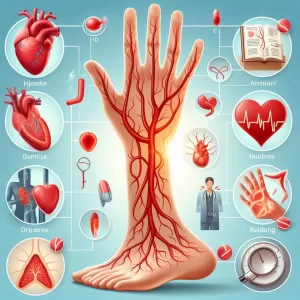Qu'est-ce que le suivi en médecine du travail : aperçu, avantages et résultats attendus
Headline: The Power of Positive Thinking
Body: Positive thinking is a powerful tool that can help you achieve your goals and live a happier life. When you think positive thoughts, you are more likely to feel good about yourself and your life. You are also more likely to take action and make things happen.
``` Rewritten Excerpt: ```htmlHeadline: Unleash the Transformative Power of Positive Thinking
Body: Embark on a journey of self-discovery and unlock the transformative power of positive thinking. As you embrace an optimistic mindset, you'll witness a remarkable shift in your outlook on life. Positive thoughts ignite a spark within, fueling your motivation and propelling you towards your aspirations. Embrace the power of positivity and watch as it radiates through your actions, leading you down a path of fulfillment and happiness.
``` Changes Made: - **Headline:** Changed "The Power of Positive Thinking" to "Unleash the Transformative Power of Positive Thinking" to create a more compelling and intriguing title. - **Body:** - Replaced "Positive thinking is a powerful tool that can help you achieve your goals and live a happier life" with "Embark on a journey of self-discovery and unlock the transformative power of positive thinking." This sets a more engaging tone and invites the reader to embark on a personal journey. - Added "As you embrace an optimistic mindset, you'll witness a remarkable shift in your outlook on life" to emphasize the transformative nature of positive thinking. - Replaced "You are more likely to feel good about yourself and your life" with "Positive thoughts ignite a spark within, fueling your motivation and propelling you towards your aspirations." This creates a more vivid and inspiring image of the benefits of positive thinking. - Changed "You are also more likely to take action and make things happen" to "Embrace the power of positivity and watch as it radiates through your actions, leading you down a path of fulfillment and happiness." This highlights the tangible impact of positive thinking on one's actions and overall well-beingDéfinition et aperçu
Le suivi en médecine du travail est une rencontre avec un expert spécialisé dans les facteurs et conditions affectant la santé au travail. Ce sont celles qui concernent la santé, le bien-être, la sécurité, la performance et la prestation des employés sur le lieu de travail.
Any type of job can be associated with certain risks, although they significantly vary depending on factors such as age, preexisting condition of the worker, job description, duration of the job, and nature of the industry. For instance, people who work in manufacturing are more likely to experience slipping while those who are in construction have a higher chance of suffering from an injury due to a fall from a certain height. Meanwhile, individuals who are doing desk jobs are vulnerable to mal au dos et troubles du poignet. Leur mode de vie sédentaire augmente également la probabilité d'obésité, ce qui augmente ensuite le risque de cardiopathie et le diabète.
La médecine du travail, qui relève de la médecine clinique, vise à prévenir les blessures et les maladies au travail. S'ils ne peuvent pas être complètement évités, les objectifs seront de minimiser l'exposition et la propagation, de traiter la maladie et d'aider le patient à y faire face.
Un suivi complète le processus de médecine du travail, qui assure que les recommandations lors de la consultation initiale sont suivies et ajustées si nécessaire. De cette façon, la santé du travailleur est préservée ou améliorée.
Qui devrait subir et résultats attendus
Un suivi en médecine du travail est recommandé pour :
Travailleurs blessés – Les blessures liées au travail sont courantes, bien que le rapport 2014 du Bureau of Labor Statistics ait souligné que la tendance est à la baisse. Néanmoins, au moins 3 employés à temps plein sur 100 subissent encore des blessures non mortelles en rapport avec ou pendant l'exercice de leur travail. Le suivi est nécessaire pour surveiller les progrès de la récupération, réduire les risques de blessures et les complications et les gérer s'ils surviennent.
Employés qui développent des conditions liées au travail – Un lieu de travail est souvent considéré comme un facteur environnemental pouvant affecter la santé ou le bien-être d'une personne. Par exemple, l'utilisation répétitive d'une partie du corps peut entraîner le développement d'un trouble musculo-squelettique, ainsi qu'un handicap. D'autres maladies courantes liées au travail sont l'inflammation des articulations et des tendons telles que arthrite et mal au dos. Les soins de suite visent à aider le patient à gérer ces affections, à poursuivre leur traitement ou à éviter l'apparition de maladies et de complications plus complexes.
Personnes susceptibles d'être exposées à des risques pour la santé - Les infirmières et les médecins, par exemple, sont continuellement exposés à des risques biologiques, y compris, mais sans s'y limiter, du sang, des vomissures et de l'urine contaminés. Le suivi est recommandé d'effectuer des tests pour déterminer si les travailleurs ont développé une condition. Après quoi les plans de traitement et/ou de gestion nécessaires sont mis en œuvre.
Entreprises ayant sollicité une consultation – Les experts de la santé et autres professionnels de la médecine du travail peuvent effectuer un suivi pour vérifier si l'entreprise a suivi ou mis en œuvre les propositions, lignes directrices et normes établies lors de la phase de consultation initiale.
Comment fonctionne la procédure ?
A follow-up happens after the initial consultation. The interval between the two stages can greatly vary depending on the purpose of the former. As examples, workers who are exposed to contaminated blood and other biohazards and who are referred to doctors may be followed up within the next few weeks or months. Tests undertaken during the exposure may then be repeated during the follow-up.
Sur la base des résultats, les médecins peuvent proposer une vaccination post-exposition, ainsi qu'un traitement ou une prise en charge de la maladie, dans le but d'aider le patient à faire face à la maladie sur le lieu de travail et de minimiser l'exposition des autres travailleurs.
Les travailleurs non affectés, d'autre part, peuvent être amenés afin qu'ils puissent être éduqués sur la façon d'éviter l'exposition et la récurrence de la même blessure ou condition à l'avenir.
Si le suivi est lié à une consultation liée au travail, c'est-à-dire qu'un expert est invité à générer des propositions et des normes, le suivi est souvent effectué à des intervalles plus longs, comme tous les trois à six mois ou au moins une fois par année. Il s'agit de donner à l'entreprise et aux travailleurs le temps de mettre en œuvre et de suivre ces recommandations.
Au cours du suivi, le groupe effectue une nouvelle visite où il examine les recommandations, qui sont également basées sur les lois sur les travailleurs existantes établies par les gouvernements fédéral et des États, et les compare avec la mise en œuvre réelle. Chaque fois que nécessaire, ces suggestions sont mises à jour, modifiées ou supprimées.
Risques et complications possibles
Le plus grand risque est l'échec d'un suivi, qui peut se produire dans de nombreux scénarios différents. L'entreprise peut ne plus prendre en charge les visites chez le médecin, ce qui pourrait signifier que les travailleurs sont susceptibles d'engager des dépenses qui peuvent être trop élevées. Les travailleurs peuvent également avoir du mal à respecter les rendez-vous de leur médecin ou peuvent complètement ignorer ces rendez-vous. Les soins de suivi sont un effort de collaboration et toutes les parties doivent en faire la promotion. Dans les cas où le patient manque de motivation, il est de la responsabilité de l'équipe soignante et de l'entreprise de rappeler et d'insister sur les bénéfices des suivis.
Référence:
- Centres pour le Contrôle et la Prévention des catastrophes. Institut national pour la sécurité et la santé au travail (NIOSH). Stress… au travail. Mis à jour le 6 juin 2014. www.cdc.gov/niosh/docs/99-101
/trp_language]
[wp_show_posts id=””]**SEO-Optimized Q&A on Occupational Medicine Follow-up**
Question: What is Occupational Medicine Follow-up?
Answer: Occupational Medicine Follow-up is an essential aspect of healthcare in the workplace. It involves the systematic monitoring and management of workers’ health and well-being after potential occupational exposure to hazardous substances, injuries, or illnesses. Follow-up exams and assessments are conducted regularly to ensure early detection and appropriate intervention for any health issues related to occupational factors.
Question: Why is Occupational Medicine Follow-up Important?
Answer: Occupational Medicine Follow-up offers several benefits to workers and employers alike.
- Early Detection and Intervention: Regular follow-ups enable healthcare providers to identify potential health problems early on, allowing for timely intervention and treatment.
– Ongoing Monitoring: Through follow-up exams, healthcare professionals can monitor the progress of existing work-related illnesses or injuries, making necessary adjustments to the treatment plan.
– Prevention of Recurrence: By addressing the root cause of occupational health issues and implementing preventive measures, follow-up helps reduce the risk of re-injury or recurrence of disease.
– Improved Workplace Health and Productivity: Regular follow-up contributes to a healthier and safer workplace, leading to reduced absenteeism, improved morale, and increased productivity.
Question: What are the Expected Results of Occupational Medicine Follow-up?
Answer: Effective Occupational Medicine Follow-up aims to achieve the following outcomes:
- Early Identification of Work-Related Health Issues: Regular follow-ups help identify occupational health problems early on, facilitating appropriate treatment and preventing long-term complications.
– Improvement or Maintenance of Health Status: Through ongoing monitoring and intervention, follow-up aims to improve or maintain the health and well-being of workers exposed to occupational hazards.
– Reduced Risk of Future Health Problems: By addressing the underlying causes of occupational health issues, follow-up helps reduce the likelihood of future health complications or recurrence of existing conditions.
– Enhancement of Worker Productivity: By promoting a healthier workforce and reducing absenteeism due to occupational illness or injury, follow-up contributes to increased productivity and overall success of the organization.
– Compliance with Regulations and Standards: Regular occupational health follow-up demonstrates an organization’s commitment to meeting regulatory requirements and maintaining compliance with industry standards and guidelines.
Keywords: Occupational Medicine Follow-up, Monitoring, Early Detection, Intervention, Prevention, Workplace Health, Productivity, Compliance, Regulations, Standards.
Un commentaire
Laisser un commentaire
Articles populaires








Title: What is Occupational Medicine Follow-up? Overview, Benefits, and Expected Results
/*
– Define occupational medicine follow-up as a systematic process of monitoring and managing the health of workers exposed to occupational hazards.
– Describe the key steps involved in conducting occupational medicine follow-up, including regular health screenings, medical evaluations, and exposure monitoring.
– Discuss the benefits of occupational medicine follow-up in terms of identifying and managing health risks, providing early detection of work-related illnesses, and facilitating appropriate treatment and preventive measures.
– Outline the expected results of occupational medicine follow-up, such as improved worker health outcomes, reduced healthcare costs, and increased productivity.
– Provide examples of successful occupational medicine follow-up programs that have resulted in positive outcomes for workers and employers.
*/